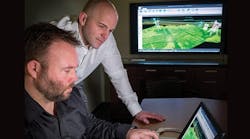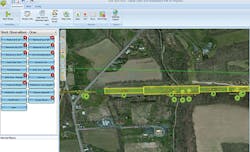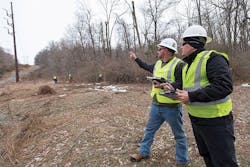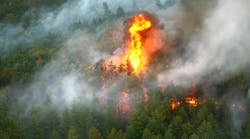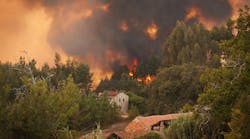With about 5,000 miles of overhead transmission lines and 29,000 miles of distribution circuits, it is no small job directing the vegetation management program at PPL Electric Utilities. As many as 1,000 tree contractor employees are working on the system in central and eastern Pennsylvania on any given day. The millions of dollars invested in vegetation management must produce both regulatory compliance and service reliability. PPL has found a way to deliver both of these more efficiently using a geospatial work management application, light detection and ranging (LiDAR) and a unit contracting approach.
LiDAR and Geospatial Work Management
Conditions were not unlike many other utilities in the vegetation management arena two years ago when PPL recognized it might be time for a change. The utility had operated for decades relying almost entirely on a paper-based operations and records management system. Multiple disparate software systems were used for work tracking, invoicing and sign-offs.
With a large and geographically diverse 10,000-sq-mile service territory to manage, PPL’s vegetation management team tasked itself with investigating alternative approaches to manage the different work and programs within the vegetation management arena. The first step was to migrate to a geospatial work management system, combining and replacing all legacy software applications while eliminating paper-based operation.
PPL had been collecting LiDAR data for about five years on its 200-kV and larger circuits for regulatory compliance purposes. LiDAR is a sensing method that uses pulsed laser light to measure variable distances to ground objects. Airborne-collected data is combined with the light pulses to create accurate 3-D information about the characteristics of surface objects, including vegetation.
LiDAR data is generally collected using a rotary-wing or fixed-wing aircraft flying at an altitude of 100 ft to 400 ft above ground level, depending on the desired collection criteria. PPL team members saw the resulting data as valuable but not being fully utilized. Therefore, they researched vendors who could integrate the LiDAR data with the work management system — through the power of PLS-CADD industry-standard software, LiDAR and algorithms — to transform data into actionable insights on specific locations.
Unit Contracts
A major driver in PPL’s decision to make this investment was the vision of moving to a unit contracting work plan model. The geospatially accurate LiDAR data combined with PPL’s intuitive work management software enabled highly accurate unit contracting in place of time- and material-based (T&M) contracts. Without the correct geospatial information, there could not be an accurate tracking of units, which are mostly in acres and linear feet.
Like T&M contracts, unit contracts require a lot of administrative support when the proper system is not in place for planning, tracking, auditing and invoicing. Because the entire process from work completion to invoicing is electronic, PPL’s new software program now handles all the administrative work for a unit contract without the need for additional administrative support.
An example unit for transmission vegetation work would be a certain price per acre for hand-clearing brush or a set price for removing a tree of a certain diameter. Unit pricing protects the utility from uncertainties such as weather delays and other factors that may drive up costs. Unit prices and a precise scope of work result in reduced costs as well as heightened contractor efficiency and accountability.
Beyond the use of LiDAR data for unit pricing, PPL also created 3-D modeling of its transmission circuits, which provides information for transmission engineering, encroachment assessments, real estate work and relay settings.
Stephanie Raymond, vice president of transmission and substations at PPL, said the efficiencies created by using advanced technology in vegetation management can only help the utility’s focus on continuous improvement.
“Embracing technology to help us serve customers more effectively and efficiently is happening across departments here at PPL,” she said. “Vegetation management is a very visible part of our business. Customers want us to do the right thing when it comes to keeping the lights on. Taking our operations to the next level operationally was a no-brainer.”
Change Management
The combined LiDAR and integrated work management software system has already resulted in significant savings and efficiency improvements, but it has expanded training opportunities, as well. Change management was an important part of the process. PPL’s entire vegetation management group and key vegetation management transmission contractors were trained on the new work management system. The result is foresters now can create annual vegetation work plans in the system and provide them electronically to the utility’s contractors, who fully understand and can quickly execute the plans.
Instead of the old T&M specification, staff members now direct contractor work based on actual field conditions using the unit cost format. From the point of creating work plans, everything is electronic and geospatially tagged in the system, including tree trimming and removal records, herbicide applications and property owner sign-offs. Staff and management can retrieve near-real-time status of work and costs.
Foresters and contractors use tough tablets and cell phones in the field to plan work, document progress and generally keep records that stay in the fully accessible, geospatially referenced files for current and future maintenance use.
“Our foresters and contractors can see data layers with access roads, regulated wetlands and tax map boundaries,” said forester Mike Trotta. “We can even pull up high-definition right-of-way and structure photos that were collected, along with the LiDAR flights to get a desktop visual of the transmission line without having to go to the field. Compare that to the old days when everything was stored in a file drawer or separate 2-D PDF files.”
Future LiDAR flyovers will enable PPL to track vegetation growth so it can optimize vegetation trimming cycles, audit contractor work performed and detect changes that may identify new encroachments.
Reliability Strategy
As a companion to more comprehensive vegetation management, PPL has been strengthening its transmission and distribution system to better withstand storms and tree contacts. Stronger poles and wires are playing a role in helping to blunt the effects of any tree contacts, and smart grid automation is helping to reduce the frequency and duration of outages.
Using technology also can help to detect causes of momentary outages (those lasting less than five minutes). PPL is focused on reducing those outages as a way to increase reliability and customer satisfaction. When the system flags vegetation that might be poised to interfere with service, PPL can be proactive and accurately tend to that location along its lines.
“There are a lot of factors in the field that are interconnected, so a comprehensive strategy is necessary to provide as big of a safety net as possible against power outages. Using technology to better manage our vegetation work is certainly part of the equation,” said David Bonenberger, PPL’s vice president of distribution operations. “We’re using everything at our disposal, and rightly so. Our customers depend on us, and it’s up to us to deliver every day.”
PPL has a great record to report regarding vegetation-related outages. The utility recently completed a multiyear effort to clear transmission rights-of-way more comprehensively, and it is also applying more encompassing clearance standards to distribution circuits.
There were no tree-related outages on PPL’s transmission system in 2015. Across PPL’s grid, the number of tree-related power outages was 37% lower in 2015 than the average of the previous 10 years.
The new work management system will help PPL move to the next step in its program, focusing on maintenance. The metrics for success will be to avoid transmission outages and comply with regulations, while also ensuring reliability, safety, customer satisfaction and efficiency.
Implementation Plan
With full implementation of the new work management system complete for transmission work as of January 2016, the vegetation management team plans to begin implementing the work management system for distribution work later in 2016 and estimates full implementation will take up to two years. Initially, the new geospatial work management system will be used for electronic work tracking along distribution circuits with accompanying unit contracts. The overall distribution program will be rolled out in phases through 2017.
Distribution is more difficult because of the volume of work and contractors. Change management again will be a critical piece. PPL believes the new approach will allow tailored pruning cycles along distribution circuits that better account for factors like terrain, growing conditions and urban versus rural environments.
The team sees technology as the future for the vegetation management slice of the business. Utilities are under increasing pressure to maintain reliability, reduce costs, increase customer satisfaction and meet ever-stricter environmental regulations.
The PPL vegetation management team and utility executives believe technology is one of the answers, given the trends of improving technology and lower technology costs now available to utility managers for collecting and maintaining accurate work records in a readily retrievable and flexible format.
“Our LiDAR-based work management system has set the foundation for what can come with the fast-moving evolution of data analytics,’’ said Joseph George, a PPL vegetation management analyst.
Technology is helping the entire utility industry be more efficient and more reliable. Vegetation management on the surface may not seem like a technical world, but innovation has its place here and it is driving continuous improvement.
Adam Morse is the manager of vegetation management at PPL Electric Utilities. He previously served in several project management roles at the utility, working on transmission and substation capital projects. Before joining PPL, Morse worked in a project management capacity building new natural gas and oil pipelines for Chesapeake Energy. Prior to working at Chesapeake Energy, he served for eight years in the U.S. Army as an officer and OH-58D helicopter pilot, serving one tour in Iraq and one in Afghanistan. Morse attended the University of New Hampshire on an Army ROTC scholarship and holds a bachelor’s degree in business administration.
